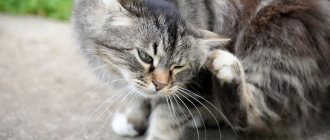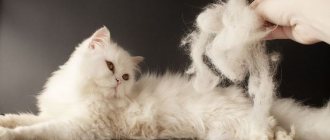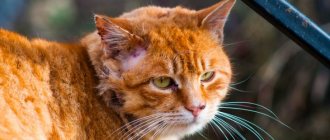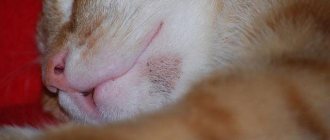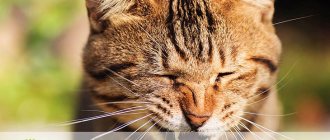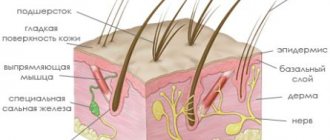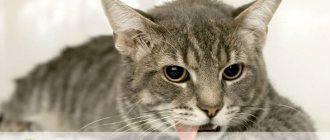Physiological causes of hair loss
One of the main signs that a cat is healthy is shiny and thick fur. But it can fall out in any animal. There are many reasons: physiology, skin diseases, severe pathologies of the body.
Shedding in cats
Sometimes the loss of part of the coat is in no way connected with diseases:
molt. Every cat sheds its coat twice a year, in spring and fall. The pet needs to prepare its coat for the change of season, but the process may take 2-3 months.
It is worth paying attention to the accompanying symptoms. When molting, he will eat well, his eyes will be clear, and his activity will be at the usual level; age
An elderly pet rarely has a thick coat. Bald spots begin to appear, hair lies in clumps. Usually there is nothing dangerous about a cat having bald spots. But it is worth observing changes in the condition and promptly contacting a veterinarian if necessary; incorrectly selected diet. Eating from the owner's table, cheap food, cheap fish or canned fish has a bad effect on the animal's health. Fried foods also negatively affect your cat's health.
If your cat's baldness does not appear for these reasons, then there are several other common causes of hair loss.
Stressful situations. Any situation that changes the normal course of a pet's life can change its condition. This can lead to baldness in a cat, nervous behavior, and even aggression. Hair loss can begin due to a long absence of the owner, castration, temporary residence in the house of a “stranger,” a sudden change in food, and so on. The cat goes bald, refuses its usual food, becomes angry and irritable.
How can a cat shed due to stress?
Bearing and feeding kittens. This condition is closely related to changes in hormonal levels, changes in the body and the need to provide babies with everything they need. Hair may fall out, but new hair will grow back fairly quickly.
During this period, it is important to feed the mother cat a high-calorie diet, provide supplements and minerals
These are not all the reasons why a cat goes bald, but among them are the most basic. If an animal is actively losing weight, itching, or behaving strangely, then this is a reason to visit a veterinarian and ask him questions regarding baldness in cats.
Attention! It should be remembered that during pregnancy a cat is not immune from lichen and other skin diseases, so it is necessary to monitor the animal. It is normal for any cat to remain clean, so he will lick his fur
After this procedure, thermoregulation is normalized, the temperature decreases, and the undercoat is leveled.
It is normal for any cat to remain clean, so he will lick his fur. After this procedure, thermoregulation is normalized, the temperature decreases, and the undercoat is leveled.
The cat licks itself until it becomes bald
But sometimes a normal process becomes intrusive. If after licking a cat's fur falls out and bald spots form on its head or body, then this is abnormal. By constantly licking the same piece, the animal damages the skin and increases the risk of infection. Wanting to get rid of the infection, the cat licks the area of skin even more. This completes the circle, and only the owner can solve the problem, but treatment must be prescribed by a veterinarian.
Bald spots often form on the stomach, along the spine and in other easily accessible places. Another indicator of excessive licking is frequent regurgitation of hairballs.
What to do if your cat's ears are going bald?
In some aspects, a cat's body is similar to a human's. For example, in cats, just like in people, problems with internal organs are reflected in their appearance. Typically, cat shedding is not something out of the ordinary, but if the hair does not recover, then you can start to worry. If a cat's ears become bald, the owner can definitely begin to take decisive measures to save his pet.
First, you need to figure out why your cat's ears are going bald. In fact, this symptom can be triggered by anything, from allergies to stress, and only a veterinarian can determine the real cause.
shutterstock
However, there are several common factors:
- Allergic reactions;
- Skin infections and parasites;
- Psychogenic influence;
- Hormonal disorders;
- Heredity.
Allergy
Allergic reactions can occur due to toxic substances and various environmental factors; A new food or medication can also provoke an allergy, as a result of which the hair on the cat’s ears falls out, the shells themselves turn red, become covered with a rash, and begin to itch unbearably, which is why the animal scratches its ears too much. Treatment is carried out in only one way - isolating the allergen from the cat's diet or environment and using medications prescribed by the veterinarian.
Skin infections and parasites
- Otodectosis or scabies. Otodectosis occurs due to infection with ear mites, which can cause purulent otitis media. The ears become red and itchy, and the itching can spread down to the neck, causing the cat to try to relieve it by scratching itself excessively. This is what causes baldness.
- Ringworm and other fungal infections. Fungi are very dangerous, so they try to exclude lichen as the cause of baldness in the first place. Emergency veterinary assistance is especially necessary if ear hair loss is accompanied by redness and rash.
- Viruses. Viral infections that cause hair loss in a cat's ears can affect any organ, from respiratory diseases to eye lesions. Only a specialist will help determine what exactly the animal is sick with and choose the right medications; self-medication can only worsen the cat’s condition.
shutterstock
Stress
Emotional turmoil does not always have a very good effect on animals. A change in the environment surrounding people can lead to the fact that their nervous system cannot stand it: the cat may refuse to eat, begin to hide, the owners may notice that its hair is falling out (on the ears and not only). If symptoms have recently appeared, you can try to calm your pet yourself. For long-term effects of stress, it is better to consult a specialist.
Hormonal disorders in the cat's body
Very often, ears go bald when hormonal problems are diagnosed. One of the manifestations of such disorders is hyperthyroidism - in 30% of cases, in addition to other symptoms, the ears become bald. A cat may also have hypothyroidism. Both of these diseases are associated with dysfunction of the thyroid gland. With diabetes, the hair throughout the body begins to dull and fall out.
Unfortunately, only a veterinarian can accurately determine the disease, so if symptoms appear, it is better to seek help.
Heredity.
Sometimes receding hairlines on and behind the ears appear as a result of a gene mutation and are passed on from generation to generation. Perhaps the ancestors of the balding cat had individuals with similar bald spots? In this case, you don’t have to worry about the health of your pet’s ears.
shutterstock
Fractures and other injuries
The most common problem that can happen to a cat's tail is a fracture, dislocation, etc. Fractures can be with closed or open wounds. At the site of a break, fracture, or severe bruise of the tail, as a rule, there is a tumor, and the animal reacts to pain when touched. If you find an open wound on the tail, before going to the veterinarian, you should treat it at home with any available antiseptic - for example, hydrogen peroxide, in order to avoid infection. If the suspected fracture is closed or a severe bruise is observed, an ice pad made in a heating pad or a regular rag should be applied to the injured area of the tail. Ice will relieve most of the pain and reduce swelling. The veterinarian will then suggest taking an x-ray and, based on its results, will provide assistance and prescribe treatment.
In a number of topics on our forum we discussed tail diseases in cats, so you can read about them, as they say, first hand: https://forum.kotodom.ru/topic2696.html https://forum.kotodom.ru/topic2712. html https://forum.kotodom.ru/topic2520.html https://forum.kotodom.ru/topic11530.html
Why is this happening?
Among the causes of baldness are:
- Lichen. Typical signs of lichen: peeling of the tail, parts of the hind legs, back and ears. An accurate diagnosis can only be made in laboratory conditions. The affected areas are illuminated with a Wood's lamp. If the fur takes on a greenish tint, treatment for shingles infection is prescribed.
- Hormonal imbalances . The cat's body secretes a special substance from the upper part of the tail. The pet distributes lubricant throughout the body while washing. Too active secretion leads to the fact that the tail peels off and becomes fat.
- Ticks and fleas . Even a domestic cat can become infected with fleas. Ticks are brought in from the street by other residents of the house. The area of the mane and tail is a favorite place for parasites, after which the cat begins to constantly itch and literally tear out the fur.
- Infection with helminths . These are parasites that form in the body. Helminths are transmitted through raw fish and meat. This leads to the cat having a loose tail, and worms become a related problem.
- Bacteria . Typical for cats that periodically go outside. Untreated wounds on the tail are a target for bacteria, which can lead to critical infection and a threat to life.
- Allergy . If your cat's tail is going bald, it could be a response to an allergy. Among the reasons: poor nutrition, cheap food, intoxication with medications. In addition, some cats react painfully to odors, particularly tobacco smoke.
- Stress . As in the case of the appearance of worms, the tail peels off during strong emotional experiences. In older cats, this is a consequence of the appearance of a new pet - a dog or kitten. In young furry animals, stress manifests itself after major home renovations, childbirth, or moving to a new place.
- Inflammation of the glands of the paraanal type . The animal begins to urinate past the tray, and the fact of irritation is confirmed by a shaking tail, which gradually becomes greasy, peels off and loses its fur.
Why does a cat go bald: reasons
Baldness (alopecia) leads to the appearance of bare patches of skin on your pet's body.
If there is too much hair, bald spots appear, the animal behaves restlessly
The main reasons for the development of pathology:
- allergic reaction;
- damage by fleas, lice;
- the presence of a scabies parasite;
- otodectosis (ear mites);
- fungal or lichen infections (dermatomycosis, dermatophytosis);
- pyoderma;
- purulent formations on the skin;
- oily seborrhea;
- deficiency or excess of thyroid hormones;
- increased work of the adrenal glands;
- diabetes;
- genetic predisposition;
- stress;
- lack of vitamins;
- chronic diseases of internal organs.
How to find out the cause of an unpleasant phenomenon?
Having noticed the baldness of their pet, owners often wonder why this happened. It is especially difficult to understand the causes of problems for those who have no experience caring for a pet. To determine exactly what to do next, you need to carefully examine the animal, paying attention to the following points:
- Skin condition. Healthy skin looks smooth. If scales, inflammation, and lumps are palpable at the site of the bald spot, this means that the animal is worried about some kind of dermatological disease, fungal or bacterial.
- Presence of insects. An external examination may reveal fleas or lice-eaters in the fur. If there are a lot of them, the question of why the cat lost hair on its tail disappears.
- Animal behavior. If the cat has become very lethargic, sleeps a lot, or has lost his appetite, most likely the reason that the tail is peeling off lies in endocrine disorders in the pet. Diseases of the thyroid gland, diabetes mellitus, disruption of the adrenal cortex - all these pathologies can lead to the fact that the animal’s tail comes off.
- Chair. If your pet begins to defecate irregularly, or suffers from constipation or diarrhea, this is probably why his hair is falling out. Baldness of the tail in diseases of the digestive tract occurs due to vitamin deficiency. Allergies often develop against the background of pathologies of the gastrointestinal tract.
- Smell. If the animal is regularly groomed, it should not emit any unpleasant odors. The stench from the anus or the smell of acetone from the mouth indicate the presence of health problems in the animal. In this case, the pet must be shown to a veterinarian.
Hair loss in cats: physiological causes
Thinning of a cat's coat and “scattering” of hairs everywhere is not always a sign of illness, although it is quite unpleasant for the owners. Wool on sofas, clothes, in plates - almost every furry owner has encountered this. The reasons for this are often trivial:
Shedding
Seasonal shedding (in spring and autumn) in cats living in apartments often drags on for 2-3 months. This is due to a violation of biorhythms and temperature conditions in the room. With extensive hair loss, the pet looks quite healthy: clean eyes, a moist nose, good appetite and normal activity.
Old age
Older cats rarely have thick fur. They often have bald spots, and long hairs remain in clumps. There is nothing dangerous in this, but it is worth remembering the increased risk of developing various diseases in older cats.
Stress
It is generally accepted that cats adapt well to any situation. Few people know that fluffies have a very delicate nervous system. Any stressful situation - the departure of the owner, a long stay in the house of guests who “didn’t like” the pet, etc. - can provoke excessive hair loss, up to complete baldness. The cat may refuse its usual food, its activity decreases, and its general health worsens.
Pregnancy
Hormonal changes and lack of vitamins in pregnant and lactating cats are manifested by baldness around the nipples. During this period, vitamin supplements and a balanced diet are especially important, which will help maintain the health of both the “mother” and her kittens.
Poor nutrition
Hair loss in cats is often caused by a lack of vitamin. group B. This often affects pets that eat human food or cheap food. Every cat lover should know: sausage, fried fish and food seasoned with salt and spices are absolutely not suitable for cats. Such a diet can not only provoke hair loss, but also cause severe gastrointestinal diseases and allergies.
Treatment
First of all, the problem that caused the baldness to begin is eliminated.
You can treat baldness of a cat's tail at home, if there are no serious reasons for this disease. But, of course, you need to consult a veterinarian for consultation, establishment of a diagnosis and receipt of all necessary recommendations and advice.
Sometimes, such a symptom, which symbolizes a disease, requires the use of antibiotics and other drugs. They fight the causes of the disease, stop hair loss and stimulate new growth.
Also, treatment consists of using: special ointments, drops, shampoos, anti-inflammatory and antihistamines, hormonal tablets, antiseptics, hydrogen peroxide and chlorhexedine, solutions and other medications. All this is used only as prescribed by a doctor.
Traditional medicine also enjoys good efficiency and effectiveness. It must be combined with taking medications to speed up the healing process. Bald areas of the tail can be lubricated with infusion of calendula and chamomile. Decoctions of yarrow and oak bark are effective.
Diagnosis of alopecia in different parts of the body
Only a doctor can determine why a cat is going bald. The basis of diagnosis includes medical history, visual examination, and microscopic examination of hair roots.
The pet's blood is examined and a scraping is taken from the skin. If a tumor is suspected, an x-ray or ultrasound is performed.
The diagnosis is partially helped by the localization of bald spots on a cat:
- Symmetrical baldness of the abdomen, thighs, sides, and front legs is a characteristic symptom of a skin disease.
- Due to stress, cats tear out hairs in the anus, on the back, paws, stomach, and inner thighs. This happens especially often in the following breeds: Siamese, Abyssinian, Himalayan.
- Hormonal disorders are usually indicated by alopecia on the bridge of the nose, base of the tail, hips, and chest. The skin ceases to be elastic.
- In the case of a lack of thyroid hormones, pet hair is easily pulled out in the pelvic area, on the stomach, chest and neck.
- Cancerous formations provoke bald spots on the stomach, chest, and paws. Oncology can cause complete hair loss.
- Vitamin deficiency is characterized by the appearance of small, round bald patches, which can unite. The skin in places where there is no fur is bright pink.
- Fungal infections are characterized by the appearance of bald spots with scaly, cracked skin.
Scratching a pet's skin is dangerous due to infection and the development of an inflammatory process.
To make it easier for you to determine the cause of your pet's baldness, we have prepared a table. It contains all the main pathologies accompanied by hair loss in a cat:
Causes of severe baldness
Baldness is easy to notice at the initial stage, as the cat leaves hairballs everywhere and bald patches appear on the skin. The ears, tail and abdominal area are most often affected. Baldness - alopecia, indicates a serious malfunction in the functioning of the body itself, but is not an initial disease and is divided into three main groups:
- allergic;
- infectious (parasitic);
- endocrine (hormonal disorders).
Based on the condition of the skin itself in areas of severe baldness, the cause of the appearance and development of alopecia is determined. In frequent cases, bald areas may show severe redness, a rash, and the skin in these areas itches, tormenting the pet. With more serious diseases, ulcers and scabs may form, the cat scratches the affected areas vigorously, and the skin in these areas loses its elasticity and becomes hot to the touch.
Diagnosis and treatment
After discovering lost hair, it is necessary to urgently show your pet to a veterinarian, since at home there is no way to understand the cause of the disease. To make a diagnosis, the veterinarian will carry out the following procedures: collect anamnesis (interview the owner about past diseases, nutrition); conduct an external examination for the presence of characteristic symptoms; will take blood and skin scrapings for study. If necessary, ultrasound diagnostics are performed. After determining the cause of alopecia, the doctor prescribes treatment recommendations:
- Fleas. Elimination of parasites is carried out using shampoos (Fitoelita, Lugovoy, Celandine), drops on the withers (Stronghold, Advocate, Bars), sprays (Delix, Frontline). For prevention, it is recommended to wear a flea collar.
- Lichen. Treatment is usually local - shampoos (Doctor, Alezan, Antifungal), ointments (Yam, Sanderm), Fungin is effective. Vaccines are common for treatment and prevention - Polivac, Vakderm.
- Avitaminosis. If the animal is fed natural products, it is recommended to add a vitamin complex. It is better to give pregnant cats special food designed for this condition. Sometimes doctors prescribe sulfur preparations and immunostimulants.
- Hormonal imbalances, dermatitis, stress - specific treatment depending on the identified problem.
- Inflammation of the paraanal glands. Treatment – massaging the anus area from the outside or inside, treatment with an antiseptic through a catheter. If necessary, antibiotics and rectal suppositories are prescribed to relieve inflammation.
- Allergy. The irritant is eliminated and antihistamines are given.
If your cat's tail comes off, then the best method of preventing this symptom is prevention. It is enough to provide adequate feeding and care, regular examinations and monitoring of the pet’s condition.
How to treat tail baldness in a cat
If the tail is peeling due to a lack of vitamins or due to old age, the animal is recommended to take vitamin complexes and immunomodulators recommended by the attending physician. Additionally, you can give him a sulfur preparation, which is sold in pharmacies.
In case of allergies, it is necessary to exclude the cat from contact with the allergen. If hair falls out due to a food allergy, then the patient needs a diet and treats are excluded. All well-known brands that produce cat food have special medicinal lines in their assortment. Anti-inflammatory and antihistamine drugs, as well as ointments with corticosteroids, are also indicated.
If the cause associated with alopecia is lichen, then, despite the danger of the disease, you should not despair. Vaccines help at the initial stage. In cases of complicated dermatitis, a course of antibiotics and immunostimulants is indicated, as well as antifungal drugs - itraconazole, ketoconazole, griseofulfin. The latter should be given along with a piece of butter for better absorption.
You can get rid of fleas and lice eaters using special shampoos with fipronil or another active substance that causes the death of blood-sucking fleas, sprays or drops that are applied to the scruff of the neck, spreading the fur. In addition, the cat needs vitamins to boost immunity. It is highly desirable to treat the entire room against fleas.
If a cat's area under its tail becomes bald due to inflammation of the paraanal gland, it is better not to delay treatment, as this disease is life-threatening for the animal. The doctor prescribes antibiotics and an ointment that is applied to the damaged area.
If a pet's tail peels off due to an infection in the wound, the inflamed area is treated with hydrogen peroxide or chlorhexidine solution. A wound that is too large, larger than a five-kopeck coin, will need to be stitched up at a veterinary clinic. Antibiotics are indicated to treat the infection, most often amoxicillin.
An animal that has experienced severe stress is prescribed sedatives.
Remember that any disease is easier to prevent than to treat. High-quality care, proper feeding, vitamins, timely examinations by a veterinarian and the absence of stress will help avoid the unpleasant problems of hair loss and baldness of the tail.
Tail ulcer
Short-haired cats often suffer from ulcers that form on their tails. These ulcers can be located throughout the tail, including at the root of the tail, which can cause necrosis of the vertebrae of the caudal process.
This disease is specific and requires strict pharmacological treatment, as well as special recommendations to the owner for treating the cat at home. The process of treating a tail ulcer also includes cleaning it of dirt and, if formed, a crust. After this procedure, the affected area of the tail should be treated with antiseptic powder and lubricated with a special product prescribed by the veterinarian. Kubatol aerosol is often used for these purposes. After such treatment, the affected area is lubricated with ointment. This can be syntomycin or streptomycin ointment, or liquid Vishnevsky liniment. After treatment, the affected area of the tail should be wrapped with a light bandage for 5 days for protection.
All this time, you need to periodically comb the fur in areas located near the affected area to prevent itching. During the procedures, it is better to protect yourself with the help of a protective circle or a “plant pot” type muzzle.
Any tail disease can only be treated under the supervision of a veterinarian.
If this disease is neglected, your pet may develop gangrene. Therefore, when you first suspect the appearance of an ulcer, you need to take the necessary measures without delay. Otherwise, a situation may arise in which there is no other choice but to amputate the tail.
Vitamin deficiency as a cause of alopecia
Quite often, a pregnant cat becomes bald near the tail. In this case, we are talking about a lack of nutrients - vitamins and microelements. A cat bearing kittens needs a special diet, taking into account the changing needs of the body. Alopecia in pregnant animals should be treated by changing their diet. If the cat's diet consists of natural food, it should be supplemented with special fortified supplements. Dry food during pregnancy must be replaced with special products intended for pregnant cats. Such foods are distinguished by a large amount of vitamins and microelements that cover the body’s need for these substances.
You might be interested in: Why does a cat not open one eye?
Vitamin deficiency also affects small kittens and older animals. This problem occurs especially often in kittens taken from the street. Due to the lack of normal nutrition, the immunity of animals weakens, against which a number of diseases develop, including hair loss. In all cases, you can get rid of the symptom only by adjusting your diet.
You should consult your veterinarian about the need to administer special supplements to older animals (over 7 years old). The fact is that at this age, alopecia may be a consequence of systemic disorders that need to be identified and, if possible, corrected.
Signs of pathology
Signs of dysfunction of the paraanal glands in a furry pet should be detected by the owner in a timely manner. This will allow you to identify the causes of this condition as soon as possible and avoid unpleasant consequences for the cat’s health.
Owners should pay attention to the following symptoms that indicate inflammation of the paraanal gland in a cat:
- Weakness and apathy.
- An unpleasant odor from the animal's body that does not disappear after washing.
- Decreased appetite.
- Swelling and soreness of the anus.
- Increased body temperature (in some cases).
- “Riding on your butt” on the floor or other rough surface.
- Meowing during defecation due to painful sensations.
- Itching in the anus and skin in the back of the body.
- Problems with defecation – the cat cannot go to the toilet.
- Hair loss in the tail area.
- Constant licking under the tail.
If your pet develops pain and swelling in the anal area, as well as an unpleasant body odor, you should immediately consult a doctor. Otherwise, inflammation can cause the development of an abscess of the paraanal glands in a cat, which often leads to death.
Why does a cat's tail or back at its base go bald?
In most cases, the culprits of hair loss on a pet's tail are parasites. They bite the animal, which tries to relieve the itch by biting and scratching. Since the tail is easier for cats to reach than other parts of the body, they usually groom it.
However, it happens that a cat’s tail comes off even without the participation of fleas. Other reasons for baldness in this area of a pet’s body are:
Ringworm in a cat
- Lichen. A fungal disease that affects the skin. Because of this, bald spots, usually round in shape, form in areas where the fungus is localized.
- Endocrine disorders. Malfunctions in the functioning of the thyroid gland or adrenal cortex lead to an imbalance in the hormonal balance in the animal’s body. This affects the activity of all organs of the cat. Cats have glands under their tail that secrete a specific secretion with which they care for their fur. If the production of this substance becomes too intense, the animal's tail may become bald only at the base or in the hip area.
- Helminthiasis. Worms can lead to the development of various diseases in animals, but primarily their presence in the body negatively affects the condition of the skin and fur of pets. To prevent helminthic infestation, animals should be given anthelmintic drugs once every 3 months and should not be fed raw meat or fish.
- Bacterial dermatological infections. Such disorders usually develop against the background of other diseases that lead to decreased immunity. One of the reasons that the cat is mangy may be poor nutrition, which has caused the animal to have nutritional deficiencies.
- Diseases of internal organs. If the gastrointestinal tract organs stop working normally, nutrients from food are poorly absorbed, their deficiency affects the work of other organs, immunity weakens due to a sluggish chronic inflammatory process in the stomach, pancreas, liver, and intestines. As a result, the cat begins to go bald.
- Inflammation of the paraanal glands. They are located near the anus and produce a substance that cats use to mark their territory. These glands also participate in the metabolic processes of the body. They are cleaned naturally when the animal defecates. If your pet becomes constipated for any reason, the glands can become inflamed, leading to the formation of bald spots at the root of the tail.
- Injury. Hair loss often begins at the site of a wound or bruise. Perhaps a car drove over the cat's tail or it was pinched by a door. In this case, it may be broken, and a bald spot will form at the site of the injury - a consequence of the inflammatory process.
Allergic reaction
Hair loss in a cat on the stomach, hind or front legs, or behind the ears is often explained by a food allergy. The most allergenic foods are fish, milk, and canned food. Intolerance is accompanied by itching. The animal is constantly itching, this leads to baldness. The most obvious signs of an allergy are lacrimation and drooling. If these symptoms appear, you should exclude the food that causes this reaction from the cat’s menu.
After taking certain veterinary medications, pets often develop drug-induced dermatitis. As a rule, the animal may become bald in the area where the drugs were administered. Why some cats tolerate medications well and others poorly is unknown. If the cat becomes obese after treatment, the product should be replaced with another one or the treatment should be stopped altogether.
Allergic reactions also include traumatic alopecia. This pathology occurs at the site of postoperative sutures, deep wounds, burns or injuries. It is no longer possible to restore hair in such areas.
The cause of fur loss on a cat's back and tail in summer may be solar dermatosis. Perhaps the animal, carried away by sunbathing, received burns and, as a result, shed.
Can the problem be prevented?
The development of alopecia on or near the tail, as well as on the back, negatively affects the appearance of the animal. However, the aesthetic side of the problem is inferior in importance to the issue of the pet’s health.
It is extremely important to notice the problem in time and begin to treat your tailed pet as soon as possible. Veterinarians recommend taking preventive measures:
- Choose a healthy diet for your animal. You should not treat your pet to raw fish or meat. It is better to feed your cat balanced dry food. Many owners practice a mixed diet, alternating dry mixtures with canned food.
- Eliminate stress from your pet's life. Emotional stress is especially harmful for weakened animals that have recently suffered from an infectious or other disease.
- Avoid contact with infected animals and follow hygiene rules. To protect your pet from parasites, you need to purchase a special collar for it. Then fleas will not attack him even in contact with a sick relative. Partially prevents infection by helminths.
Source
Causes
Among the reasons that lead to a cat going bald at the tail are:
- various skin diseases. In such cases, the cat feels severe itching, which it cannot tolerate and scratches, thus combing out pieces of fur. Often large foci of the disease appear and are localized precisely on the tail, at its base. Here it is worth using different shampoos, drops and ointments to eliminate the problem and return the cat to a normal rhythm of life;
- oily seborrhea. These are disturbances in the functioning of the glands that produce fat necessary for the life of pets. If a lot of it is produced, then the hair falls out as a result of too oily skin. The opposite cases also occur when there is a lack of fat production. As a result of this, the skin dries out greatly, and hair also falls out profusely, primarily affecting the pet’s tail;
- dermatomycosis. This is a set of fungal diseases that are transmitted to a healthy pet literally in the first minutes of interaction with an infected individual. The cat's fur becomes weak, brittle, falls out a lot, bald spots appear on the tail and behind the ear, and on the back;
- Hair loss of a cat's tail also occurs due to diseases of the digestive system. There may also be vomiting and diarrhea;
- stress Moving, a long trip, a change of environment or owners can cause a cat to shed its tail. This may also be accompanied by a lack of appetite, irritability, aggressiveness, weakened immunity and disruption of the functioning of the gastrointestinal tract;
- lack of vitamins. If severe hair loss and baldness on the tail are noticeable, you need to introduce vitamins and minerals into your pet’s diet to replenish the body’s reserves. First of all, these are: iron, calcium, phosphorus, potassium. Also, it is worth reviewing the cat's menu and perhaps changing it a little. An animal may suffer from a lack of vitamins during pregnancy or lactation;
- sterilization After this procedure, it is quite possible that the cat’s hormonal levels will be disrupted, which will cause the tail to begin to go bald at the base. This is called endocrine alopecia.
Also, hair can fall out due to: allergies, lichen, tick bites, infectious parasites.
Causes of baldness in cats
Hair loss in cats can be caused by various reasons. The violation may be caused by:
- Viral or bacterial infection.
- The fungus that causes ringworm.
- Cheyletiellosis associated with infection by a microscopic mite.
- Allergies caused by poor diet or contact with household chemicals.
- Hormonal imbalance that can occur in castrated or sterilized individuals.
- Constant stress that negatively affects the coat and the entire body.
In some cases, alopecia is caused by constant stress, oncology, chronic pathologies affecting the organs of the digestive system, and the presence of fleas in the pet. If a cat is going bald, the reasons may also be poor nutrition, which creates a deficiency of vitamins and minerals in the body, mechanical damage to the skin (burns, injuries associated with jumping, climbing trees, contact with sharp objects).
Baldness in a cat can be provoked by giving him medicinal injections. In this case, the hair becomes scanty directly at the injection sites. The cat's owner will not need to do anything. Gradually the vegetation will recover on its own.
Causes of hair loss
Among the conditions that cause hair loss at the base of the tail and along its entire length are various pathologies, both skin and systemic. Possible reasons for the appearance of such a specific symptom:
- Endocrine disorders;
- Avitaminosis;
- Dermatitis and dermatomycosis;
- Disruption of the gastrointestinal tract;
- Parasites;
- Lichen.
In most cases, if a cat's tail comes off, the reason lies in parasites. In this case, the animal independently tears out the fur, combing and biting the base of the tail in an attempt to get rid of fleas. Alopecia is often accompanied by the appearance of wounds and erosions, which are caused by constant scratching of this area. Diagnosing parasites is simple - just carefully examine the animal’s skin. Even if fleas are not noticeable, nits may appear. They resemble small black dots that are difficult to see with the naked eye. In animals with sensitive skin, nits can cause irritation, which is accompanied by itching and forces the cat to scratch the affected area.
Another common cause is ringworm. A fungal disease is manifested by the formation of a bald spot of a regular shape on the cat’s skin. In the affected area, the fur thins and scabs or peeling appear. The disease progresses quickly and, if the lichen is localized at the base of the tail, over time it spreads to the entire length of this part of the body and the back of the animal
It is important to remember that lichen is highly contagious for both animals and humans. It must be treated with special ointments and solutions for treating the skin.
Endocrine disorders
Causes of alopecia in animals include hormonal changes, metabolic disorders and obesity. If, after castration, the cat’s tail has peeled off at the base, this is a manifestation of hormonal alopecia. The same is true for cats that have recently undergone sterilization. The animal’s hormonal levels can normalize on their own, but in some cases drug therapy is necessary.
When metabolic disorders occur in overweight animals, hormonal imbalance is also observed. Such cats need dietary nutrition, the introduction of vitamin and mineral supplements into the diet and medication.
Causes of severe baldness
Baldness is easy to notice at the initial stage, as the cat leaves hairballs everywhere and bald patches appear on the skin. The ears, tail and abdominal area are most often affected.
Baldness (alopecia) indicates a serious malfunction in the functioning of the body itself, but is not an initial disease and is divided into three main groups:
- Allergic;
- Infectious (parasitic);
- Endocrine (hormonal disorders).
Based on the condition of the skin itself in areas of severe baldness, the cause of the appearance and development of alopecia is determined. In frequent cases, bald areas may show severe redness, a rash, and the skin in these areas itches, tormenting the pet.
With more serious diseases, ulcers and scabs may form, the cat scratches the affected areas vigorously, and the skin in these areas loses its elasticity and becomes hot to the touch.
Typical symptoms
Signs of developing alopecia are easy to detect even without veterinary education. The first symptom is thinning hair on the sides of the body, behind the ears, and in the tail area. Progressive pathology provokes the appearance of other characteristic signs:
- hair loss in large clumps;
- exposing areas of skin that acquire a pink or reddish tint;
- formation of unsightly crusts in areas affected by alopecia.
If your cat is going bald due to a serious medical condition, sores, scabs, or whitish bumps may form in the problem areas. The skin in the bald area sometimes becomes hot and loses its natural elasticity.
Atheroma
The origin of atheroma is fundamentally different from lipomas. Atheroma develops from the sebaceous glands of the skin. For various reasons, the gland duct becomes clogged, secretion accumulates in the gland, which gradually begins to increase in size. Atheroma is defined as a small (from 0.5 to 2 - 3 cm) formation, which always rises somewhat above the skin and is always fused to it (i.e. the skin above the atheroma does not move), and can grow slowly. Atheroma always has a capsule and contains atheromatous masses resembling crushed lard.
Because The atheroma is connected to the external environment by a duct; there is always a threat that it will become infected through the duct and suppuration will occur. In this situation, moderate pain appears in the area of the previously “quiet” atheroma, the formation quickly (over several days) increases in size, redness appears around it, and body temperature may rise. Suppuration of atheroma requires urgent surgery.
Diagnosis and treatment
After discovering lost hair, it is necessary to urgently show your pet to a veterinarian, since at home there is no way to understand the cause of the disease. To make a diagnosis, the veterinarian will carry out the following procedures: collect anamnesis (interview the owner about past diseases, nutrition); conduct an external examination for the presence of characteristic symptoms; will take blood and skin scrapings for study. If necessary, ultrasound diagnostics are performed. After determining the cause of alopecia, the doctor prescribes treatment recommendations:
- Fleas. Elimination of parasites is carried out using shampoos (Fitoelita, Lugovoy, Celandine), drops on the withers (Stronghold, Advocate, Bars), sprays (Delix, Frontline). For prevention, it is recommended to wear a flea collar.
- Lichen. Treatment is usually local - shampoos (Doctor, Alezan, Antifungal), ointments (Yam, Sanderm), Fungin is effective. Vaccines are common for treatment and prevention - Polivac, Vakderm.
- Avitaminosis. If the animal is fed natural products, it is recommended to add a vitamin complex. It is better to give pregnant cats special food designed for this condition. Sometimes doctors prescribe sulfur preparations and immunostimulants.
- Hormonal imbalances, dermatitis, stress - specific treatment depending on the identified problem.
- Inflammation of the paraanal glands. Treatment – massaging the anus area from the outside or inside, treatment with an antiseptic through a catheter. If necessary, antibiotics and rectal suppositories are prescribed to relieve inflammation.
- Allergy. The irritant is eliminated and antihistamines are given.
If your cat's tail comes off, then the best method of preventing this symptom is prevention. It is enough to provide adequate feeding and care, regular examinations and monitoring of the pet’s condition.
Skin diseases
Dermatitis is always accompanied by itching, so the cause of tail baldness is not illness, but discomfort, due to which the cat is forced to scratch the skin, which leads to hair loss. Dermatitis is treated with ointments and shampoos. The cause of the disease may be waste products of parasites, bacterial infections or an allergic reaction.
Another cause of hair loss is fungal diseases. The disease is characterized by flaking of the cat's skin, sometimes itching. A specific symptom is uniform patchy baldness in the affected area. For treatment, antifungal drugs are used in the form of ointments, solutions and shampoos. The animal is prescribed gentle nutrition for the entire duration of treatment.
Hair loss on the back and tail can be caused by dysfunction of the sebaceous glands located in this area. Only a veterinarian can accurately diagnose the cause of alopecia in a pet. Treatment can be carried out at home, but with the condition of timely detection of the disease that triggered the cat’s hair loss.
You may be interested in: What to do if a cat has lichen?
What to do if your cat’s stomach and hind legs are going bald: treatment
Treatment consists of eliminating the causes of the disease:
- Conduct a diet analysis and switch to premium or higher hypoallergenic ready-made food. With this approach, no additional vitamin supplements are required.
- Bring content parameters in accordance with standards. Move the cat's bed away from the heating radiator and use a humidifier.
- Use antiparasitic insecticides to kill lice eaters, fleas, and at the same time helminths. Drops of Spot-on, IN-AP or analogues are in demand.
- Discontinue medications that may cause allergic reactions. Report this to your veterinarian.
- Use anti-stress medications: Stop-Stress, Stop-itching, Vetspokoin.
Be sure to read:
Bald patches in a cat near the ears and above the eyes: reasons, what to do, how to distinguish normal from pathology
If the measures taken do not lead to the desired result, contact a specialist.
Oncological diseases
Cancer tumors cause many negative processes in a living organism. The tumor grows rapidly, robbing the body of nutrients, blocking the blood flow at its location, disrupting the functioning of the body, so hair loss is a fairly common symptom of oncology. The most dangerous pathology in which a cat goes bald is skin cancer. You can suspect your pet has a terrible disease based on the following symptoms:
- enlarged lymph nodes;
- sudden weight loss;
- strongly noticeable unpleasant odor from the mouth;
- purulent discharge from any part of the body;
- loss of appetite;
- dyspnea;
- non-healing wounds or ulcers.
Oncological diseases are treated primarily surgically; after surgery, the animal undergoes a course of chemotherapy. If hair falls out between the hind legs, back, belly or face, there is no need to worry: this is a natural reaction of the body to anti-cancer drugs.
Prevention means
Why a cat's tail comes off can only be determined by a qualified specialist. The reason for this may not be a disease, but the body’s reaction to seasonal changes.
A common phenomenon is spring vitamin deficiency. After prolonged winter cold, animals experience a lack of vitamins. This usually results in shedding, but can also lead to complete baldness of the tail. It is noteworthy that such problems are more common in unneutered pets.
Prevention agents are mineral complexes added to the daily feed. You can find safe and original food in veterinary pharmacies. Professionals recommend giving vitamins in their pure form: tablets are poorly absorbed and are not always accepted by cats.
You can find vitamins in natural foods. This is sprouted grass, grated carrots. If your cat flatly refuses to eat plant foods, there is no need to worry. This means that the balance of nutrients is normal and the problem lies elsewhere. A pet in need of vitamins will eat a healthy dish without an invitation.
Source
